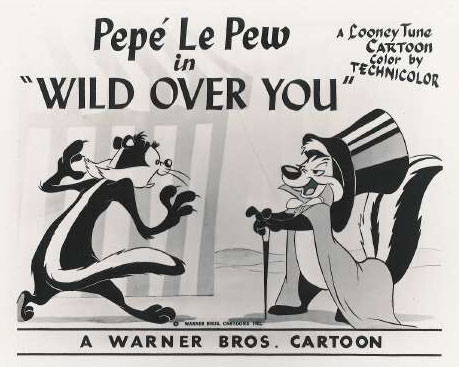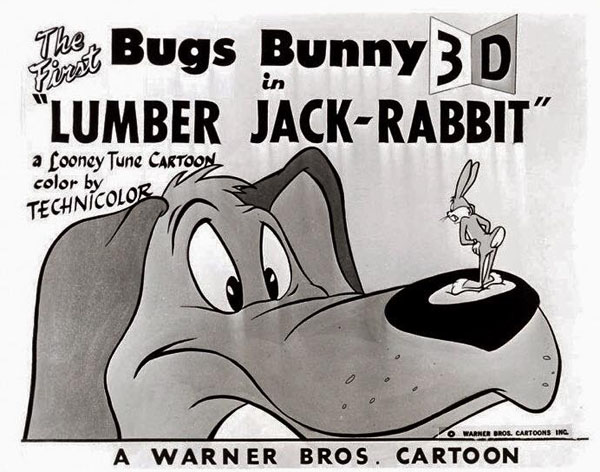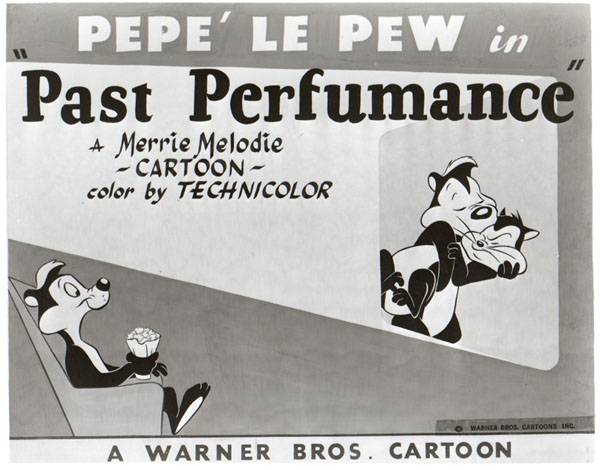1953 brought new tumult to the film industry, fighting to keep its prominence as “your best entertainment’ against the competing offerings of broadcast signals, accessible for free upon the purchase at a then exorbitant price of a TV console. The trick was to offer something (besides color) that couldn’t be had on the small screen. Thus began the short-lived craze for 3-D film entertainment, and the later and more lasting move to offer widescreen vistas for the eye to behold in place of the traditional and more confining Academy film ratio (the latter move having curiously been virtually ignored during a brief period circa 1930 at Fox, when several films traditionally shot were also offered in “Grandeur” widescreen prints for those few theaters willing to adapt to show them). This was the period when Warner closed its studio briefly in a failed anticipation of moving to production of all its cartoons in 3-D, and was releasing backlog material, some actually produced about a year earlier. But much of it remained memorable, and they continued to use songs out of their reliquary. This was also the period when Carl Stalling began to give way to his orchestrator, Milt Franklyn. Franklyn may not have had the training in accompanying silent pictures that Stalling had, but his work certainly was head and shoulders above the kind of “canned” music which for a time would later be utilized and credited to John Seeley, and eventually make its way into the underscoring of Gumby and Hanna-Barbera, as well as many live-action series.

Duck Amuck (2/25/53) – The classic Chuck Jones war between character and animator, with Daffy Duck facing a run for his money at the hands of a new and unknown wielder of the artist’s paintbrush, whose unpredictable pranks drive the duck more berserk than usual. A new musical arrival is cleverly interpolated into a sequence where Daffy tries to get the artist to listen to reason – “Can’t We Talk It Over?” It was recorded concurrent with its introduction in the 1930’s by Jack Denny of Victor, Red McKenzie on Columbia, Ruth Etting on Oriole and the ARC labels, Bing Crosby on Brunswick (with organ accompaniment by Helen Crawford (Mrs. Jesse Crawford) piped in by wire from the Paramount Theatre about a half a mile away from the studio), and Ben Bernie on Brunswick. Versions also appeared in England by the Durium Dance Band (Lew Stone, dir.) on flexible Durium records, Roy Fox (possibly with Al Bowlly) on British Decca, and Len Fillis and his Hawaiian Orchestra on British Decca. Slightly later, Jack Teagarden would perform it on Varsity, Eddy Duchin on Columbua, LaVere’s Chicago Loopers on Jump and Red McKenzie in revival on AFRS V-Disc. At the time of this cartoon, the song had been recently revived by the Andrews Sisters and Gordon Jenkins on Decca, Toni Arden on Columbia, and the Fontaine Sisters with Hugo Winterhalter on RCA Victor. Returning numbers also include “Song of the Marines” and “Captains of the Clouds”, as Daffy tries out some navy and aur force uniforms.
Fowl Weather (4/4/53) – Granny goes off for a ride, after warning Hector the bulldog of the dire consequences that will happen to him if anything happens to Tweety. Sylvester comes along with the usual appetite, and the chase goes on all over the farmyard. When Granny returns, Sylvester is forced by Hector to play “canary” in the cage – and Granny never notices the difference, much to Tweety’s consternation. Songs: Over the titles you hear “In a Little Red Barn (in a Farm Out In Indiana)”, recorded by Frank Luther on Perfect, the Light Crust Doughboys on Vocalion, Chick Bullock and his Levee Loungers on Romes/ARC labels, and Leon’s Lone Star Cowboys on Decca. A television performance from a few years after the cartoon features the interesting pair-up of Rosemary Clooney and Judy Canova Also returning, “Down in Nashville, Tennessee”.
Southern Fried Rabbit (5/26/53) – The carrot crop up North produces only scraggly limp specimens. Bugs spots a headline boasting of a record carrot crop in Alabama, and sets his feet Southward. He doesn’t realize the Mason Dixon Line is still being guarded by Confederate soldier Sam, who, when informed by Bugs that the war ended about 90 yeaers ago, responds, “I’m no clockwatcher!” After a number of gags set around an antebellum Southern mansion, Bugs dresses as a Confederate messenger, and informs Sam that the Yankees are in Chattanooga – and they are – for an exhibition baseball game, where Sam holds the team at bay in the dugout. Songs: “Are You From Dixie?”. a 1916 pop song recorded by the team of Billy Murray and Irving Kaufman for Victor, the Peerless Quartet on both Columbia and Pathe. Anonymously on Columbia’s “Little Wonder” series of mini-discs, and in a later novelty revival br Freddie “Schnickelfritz” Fisher on Decca.
Also: “I Never See Maggie Alone” was recorded in 1927 by Waring’s Pennsylanians on Victor, and slightly later the Smith Brothers on Perfect. It received much later revials, most likely the versions to catch Stalling’s attention, by Kenny Roberts on Coral and Art Mooney on MGM. “Just Before the Battle, Mother”, a traditional civil war number, and Sousa’s “Washington Post March” (which received recurring performances on victor by Sousa’s Band), also are new to the musical mix. Returning old chestnuts include “Old Black Joe”, “Swanee River”, “My Old Kentucky Home”, “Jeannie With the Light Brown Hair”, and “Yankee Doodle”.

Wild Over You (7/11/53) – A wildcat gets the inevitable stripe down her back with paint, and finds herself being pursued by the ever-amorous Pep Le Pew. Pepe’s reaction to the display of flashing claws: “Flirt”, delivered with the usual Pepe elan. Songs: “Cherie, I Love You”, a 1926 pop song recorded by Ross Gorman for Columbia, Waring’s Pennsylvanians for Victor, Ben Bernie on Brunswick, The Harmonizers on Harmony/Velvet Tone, Jesse Crawford on Victor, the Newport Society Orchestra on Broadway, and Annette Hanshaw on Perfect. It received a more-contemporary revival from Frankie Laine on Mercury. A return for “It’s Magic” is also included in this short.

Lumber Jack Rabbit (11/13/54) – The one and only 3-D offering from Termite Terrace – which almost caused the studio to give up altogether as too costly and labor-intensive a proposition. Bugs Bunny wanders into Paul Bunyan’s territory, staking a claim to a “carrot mine” in Paul’s giant garden. Watchdog Smidgen (much more sizeable than his name) proves a formidable obstacle to Bugs’ mining activities, until sent off to visit the giant redwoods. Principal number, sung by Bugs throughout the film, is “Blue Tail Fly”, a song associated with pre-civil war entertainment, but at the time most recently associated with a hit revival by Folk singer Burl Ives on Decca. The song had actually been recorded earlier by Burl for AFRS V-Disc 430 during the 1940’s. A few competing versions appeared but got nowhere, including Bradley Kincaid on Majestic. The song eventually became a kiddie record staple, appearing on almost every children’s label at one time or another.

My Little Duckaroo (11/27/54) – Daffy as the “Masked E-venger” and Porky as “Comic Relief” wander into another epic confrontation with Nasty Canasta. Daffy is his usual bombastic self, and attempts several disguises when his own hero persona fails to impress the villain, including The Frisco Kid and Superguy, and a verbal reference to Captain Video. Daffy vows to fix Canasta’s “little red wagon” – which he ultimately does, complaining about the deplorable condition the kiddie conveyance was in . The only notable music cue is what appears to be an original song performed by Porky in the opening sequence bearing the title “Lazy Willie”. Does anyone know if Maltese or someone else gets composer credit for this number?

Pizzicato Pussycat (1/1/55) – A UPA-style tale of a suburban household where the animal residents (a cat and mouse) have unusual musical talent, leading to the attempts of the human couple to profit by these talents. But they are not as successful as UPA’s McCloys, and resign themselves to home entertainment from their gifted pets without further publicity. The general concept of this film would e lifted by alex Lovy for Walter Lantz’s Maggie and Sam episode, The Talking Dog. And, of course, some may see less direct inspiration for the film from Tom and Jerry’s Johann Mouse. Songs include “Libestraum #3″ by Franz Liszt (the most familiar of a series of nocturnes written by him for the piano). It was recorded as a swing number by Tommy Dorsey on Victor, and by Spike Jones as a comedy on RCA Victor. Also featured is “Crazy Rhythm”, a 1928 song from the musical revue, “Here’s Howe”. It was recorded by Roger Wolfe Kahn on Victor, Harry Reser’s Syncopaters on Columbia, Ben Bernie and his Hotel Roosevelt Orchestra on Brunswick, Miff Mole and his Little Molers on Okeh, and vocal performances by Johnny Marvin on Victor and by Jack Smith (the Whispering Baritone) on HMV in England.

Past Perfumance (5/21/55) – Another chase between Pepe Le Pew and Kitty, changing locales to a French silent movie studio (allowing Pepe to not only chase audiences out of screening rooms (“That picture stinks”), but actors right off the screen (“Let us take it on le lamez-vous.”) The only new musical notable is what may again be a studio original, though the lyric is not fully performed past four lines (“We had no place to go, so I took her to a show. I don’t know what was on the screen, for I loved her on the mezzanine.”). Was this some risque doggerel of the period, or an actual original composition? And if the latter, where’s the rest of the lyric and melody? As you would expect, I know of no recordings of the item.
To Be Continued: 1955-56 tunefests next time.


 James Parten has overcome a congenital visual disability to be acknowledged as an expert on the early history of recorded sound. He has a Broadcasting Certificate (Radio Option) from Los Angeles Valley College, class of 1999. He has also been a fan of animated cartoons since childhood.
James Parten has overcome a congenital visual disability to be acknowledged as an expert on the early history of recorded sound. He has a Broadcasting Certificate (Radio Option) from Los Angeles Valley College, class of 1999. He has also been a fan of animated cartoons since childhood.











































Another notable feature of “Lazy Willie” is that Porky is singing the song in the key of B-flat, but the guitar accompaniment is in G. The combination creates a few odd dissonances, but for the most part it works out.
Bitonality is sometimes used in cartoons for comic purposes, for example over the opening credits to “Robot Rabbit” (Freleng, 1953), where “What’s Up, Doc?” is played in keys a tritone or a major second removed to give the effect of a broken-down music box. That cartoon, incidentally, opens with Elmer singing “In a Little Red Barn on a Farm Down in Indiana”, with bugs joining in on the harmony.
Crazy Rhythm is also well known as the “playout” song for the BBC radio comedy The Goon Show, appearing at the end of many of their shows released on CD/cassette played by the orchestra conducted by Angela Morley (Wally Stott), with The Ray Ellington Quartet and Max Geldray taking the lead.
Some trivia on Fowl Weather: According to the cartoon’s cue sheet (https://ibb.co/SyKgCYv), “Going Home” by Max Steiner (previously heard in the live action film Saratoga Trunk) was supposed to be used, but at some point it was dropped. Maybe it was supposed to play over the title cards? (minor correction: “In a Little Red Barn” plays over the opening shot, not the title cards)
Duck Amuck quotes Richard Wagner yet again, this time a brief snippet of “Rienzi Overture”, specifically the “Erschallet, Feierklänge” segment, when Daffy is tapping the anvil. This cue is also heard in A Peck o’ Trouble from the same year. Link: https://www.youtube.com/watch?v=WF7lQvjDHvE
One thing I’m surprised you skipped over in the last couple posts is that a handful of shorts around this time used some songs from “About Face”, a 1952 musical with music by Peter de Rose. Songs include “Spring Has Sprung” (heard in A Street Cat Named Sylvester and Wild Wife), “Piano, Bass, and Drums” (heard in Cat-Tails for Two and Dog Pounded), “Wooden Indian” (heard in The Oily American) and “If Someone Had Told Me” (heard in Catty Cornered). It may be one of the last instances of Warner Bros. plugging then-recent songs in their cartoon library.
That passage in “Duck Amuck” isn’t from the Rienzi Overture. It’s from a chorus in Act II of the opera.
The Blue sky boys, Bill and Earl Bolick were one of the best brother duets.
They had a radio program down here in Atlanta in the 1930’s.
I have many of their 78’s. They recorded some of the best gospel music I’ve ever heard.
“Crazy Rhythm,” by Caesar, Meyer and Kahn, was very effectively utilized by Francis Coppola as an infectious, toe-tapping duet for the great Gregory and Maurice Hines in THE COTTON CLUB (1984).
In the film, the two brothers bitterly argue and split professionally (and personally) for a time. They reconcile late in the movie, when one of the brothers impulsively calls the other up on stage to reprise their old signature number… and while singing and dancing, the two brothers suddenly remember how much they mean to each other and are almost overcome with emotion. It’s the most moving thing in the picture.
As you might imagine, “Little Red Barn on a Farm…” got a lot of use on Indiana radio and TV. WKJG-TV in Fort Wayne aired a agriculture (farm) show called “The Wayne Rothgeb Show” starting in 1951, in which somebody invariably sang about the little red barn. I don’t know which recording they used. Some old timers refer to it as “Wayne Rothgeb’s LIttle Red Barn.” My future wife appeared on that show as a junior fair participant. And of course Ft. Wayne’s WOWO radio featured lots of farm programming with “Little Red Barn” popping up here and there. And here’s a treat… a recording from 1968 sung by Nick Clooney… George’s dad. https://www.youtube.com/watch?v=HVjfAX858fQ
RobGems68 Wrote:
“SING, YOU BUZZARD!”
I always thought that line was funny as a kid yelled at by Hector The Bulldog when he made Sylvester disguise himself as a canary. I originally saw it on CBS’ “The Bugs Bunny/Road Runner Hour on WJBLK-Channel 2 in Detroit. I recall first seeing “Southern Fried Rabbit” on Channel 50, where they (shockingly!) left in the entire sequences, including the now-infamous “slave whipping/Abraham Lincoln” gag (“What’s This I Hear About You Whipping Slaves?!” “Never Mind The But’s, Here’s My Card, Look Me Up At My Gettysburg Address!”) without severe edits, a bad habit the network usually had at the time. Today, they probably wouldn’t show that episode at all (since Channel 50 has today been a part of C-W Channel, an affiliate of Warner Brothers and Paramount Pictures, which has a very large African American audience.) “Lumber Jack Rabbit” probably wasn’t as impressive on a small 10 or 20-inch TV screen when Channel 50 re-ran it as it was on 3-D movie screen, but the one thing that always was impressive was at the beginning at the cartoon, when The Warner Brothers W-B shield abruptly pops out of nowhere on the screen several feet closer than usual, with a slightly loud “thud” noise. It used to be slightly scary to me as a very small child, but I grew to love it. I often wondered what the other unreleased or shelved “3-D” cartoons W-B had planned at the time; 3-D was a very short-lived fad, barely lasting a year and a half.
As for Maltese, go to BMI and search
https://repertoire.bmi.com/Search/Search?Main_Search_Text=Maltese&Main_Search=Catalog&Search_Type=all&View_Count=20&Page_Number=2&Part_Type=WriterList&Part_Id=H5xHELjuqQ4nOGWICh1w%252bQ%253d%253d&Part_Id_Sub=kJU0oBsMXpxafbSwXsKwYQ%253d%253d&Part_Cae=YO0HedHMatLb45JzS23DVw%253d%253d&Original_Search=Writer%2FComposer
Somewhere at one time, the database credited him for “The Flower of Gower Gulch,” but I can’t find it now.
It’s worth noting that “Pizzicato Pussy Cat” with it’s UPA-influenced designs would foreshadow WB’s ultimate full-length animated feature, Gay Purr-ee , produced in collaboration with their one-time rivals, 7 years on.